

Journey’s End: Solar Impulse Lands in Abu Dhabi
Newsletter
It’s been a long and exciting journey but after more than 16 months, of which over 500 hours were spent in the air, Solar Impulse 2 has ended its around the world trip, landing safely in Abu Dhabi.
“This tremendous feat is another proofpoint that we have entered a period of remarkable growth for renewable energy,” said Adnan Z. Amin, Director-General of IRENA, of Solar Impulse 2’s landing at UAE’s Al Bateen airport. “This remarkable achievement is not only a technological breakthrough but also a clear signal that the age of renewable power is here to stay.”
The historic journey of the world’s favourite solar plane, broke eight world records and travelled 42,000 km without using a single drop of fuel. “If an airplane has succeeded to fly day and night without fuel, then we can power our world on clean energy,” says Bertrand Piccard, one of the plane’s two pilots and a founder of the project.
Piccard piloted the final leg of the journey from Cairo to Abu Dhabi, a trip delayed by wind and seasonal weather over the Arabian Peninsula, and covered roughly 2,700 kilometres in a little under 49 hours. Exiting the plane, the pilot proclaimed the world no longer needed to rely on carbon emitting energy sources, and that more than a historical moment in aviation, Solar Impulse’s successful journey was an achievement for renewables.
A remarkable plane
Traveling at an average speed of only 75 km/h, what Solar Impulse lacks in speed it makes up for in ingenuity. Its four propellers and batteries are charged by approximately 17,000 solar panels that over the course of the journey produced over 10,000 kWh of solar energy.
“To produce that kind of energy the plane uses special ultralight and efficient solar cells,” says Francisco Boshell, a renewable energy analyst at IRENA. “They’re not like the solar panels you get on your house, they’re much lighter but still with an efficiency around 23%, opening a range of new applications for the aerospace sector and beyond.”
Staying light and efficient was a priority for the 80 engineers and technicians that worked on the plane, and that priority has been a key to the craft’s success. Weighing only 2.3 tonnes and with a 3.8m3 cockpit — enough room for just one pilot — the sun-powered craft has a wingspan of 72m, similar to the 400 tonne A380 jet airliner. The array of photovoltaic cells provide the extremely efficient engines with enough power to allow the plane to fly at 29,500 feet — the height it climbs to before gliding down to 5000 feet when the sun fades.
Solar impact?
Though it’s unlikely that a fleet of Solar Impulse-like planes will be soaring through our skies anytime soon (it’s not physically feasible to power a modern airliner with only solar panels), the developments and engineering feats achieved through the Solar Impulse project are extremely innovative and are making an impact beyond aviation. Solar Impulse’s parts and components involved the cooperation and support of a large number of private firms. Innovations by these companies during the development of the plane are now being applied to cars, elevators, escalators, and more.
It has been suggested that the plane’s specially developed battery binders could be used to upgrade electric car batteries and grid storage systems. Conventional cars, and all engines in general, could benefit from the engineered additive used to upgrade the Solar Impulse’s motors’ lubricant and make the engine more resistant to wear and rust.
Solar Impulse’s motors are extremely efficient — a world record 96% efficient in fact — and part of that is due to its smart sensors, which if applied to all industrial electric motors, could save the world 616 billion kWh of electricity per year.
The various advancements in motor and energy efficiency developed could be applied to elevators, and composites created to reduce the weight of the plane are of interest to the aerospace and automotive industries.
The plane’s windscreen is made from a special polycarbonate that is both light, clear, and resistant to extreme conditions. That polycarbonate is now being applied to fruit and vegetable solar dryers in South-East Asia, and could be further used by the automotive industry. A rigid, strong, and light polyurethane insulation foam engineered to protect the plane’s batteries, has applications in cheap food storage, and may even be produced as prefabricated panels for affordable homes.
But beyond the engineering and design feats of the project, the plane and the journey was an inspiration to the world and a demonstration to innovators and decision makers that renewable technologies can really power our planet.
“By demonstrating that renewable energy can provide sustainable, reliable energy today, and that innovative solutions can unlock even more potential in the future, Solar Impulse has been able to both raise awareness about the tremendous promise of renewable energy and push technological boundaries forward,” said Amin.
(Photo: Solar Impulse Flickr, Video: Tessa Schmedding, IRENA)




